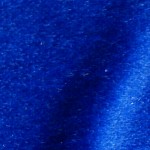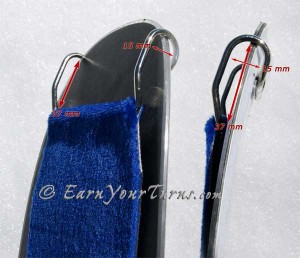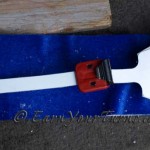First Impressions – April 2011
What struck me first was the deep blue hue. For 2011, that’s the color of Colltex’ 65/35 Mohair/Nylon mixed plush. More than that though it was nice to see a simple, solid-colored plush that wasn’t too bold, yet was distinctive.
The next thing I was relieved to notice was that these were only 90mm wide, the width requested. It’s getting darn near impossible to get a straight climbing skin less than 100mm in width anymore. I know, most of you like wide skins for your phat skis and you want to trim ’em wall-to-wall so you have as much grip as possible so you can follow or set a competitively angled skin track. Good for you, but that’s not for me. I’ll ‘splain why in much greater detail in a future post. For the moment I’ll just add that being in the minority creates a small inconvenience when it comes to outfitting a new pair of climbing skins, and that is the process of cutting them down to size. I’ll spare you the details but trust me, making perfectly straight, parallel cuts is more difficult than trimming to the shape of your ski. Thus, it was a relief to be spared that task before putting them to work earning my turns.
Glue
Out of the box the glue is nice and tacky, but not too tacky. It still takes a fair amount of effort to separate when stuck glue-to-glue, but not too much. On their maiden voyage they peeled off the bases of a my skis in a single sweeping rip. By comparison, a five year old pair of 90mm G3 skins (gray plush) reduces a smooth ripping motion to a slow, resistant tug. Too sticky for my taste, so the first rip with these Colltex was encouraging.
By my third tour the glue was already staring to change, but not in the direction expected. For the moment the glue has become noticeably stronger. Part of this is due to the surface of the glue becoming mottled from storing glue-to-glue. I don’t think the chemical composition is becoming stronger, but the texturing of the surface is creating more adhesion. I can still rip these skins from my skis in a single swoop but only when I use my arms and legs in concert. For skins fatter than 100mm it is probably difficult, but not impossible, to rip these skins with your skis still on your feet. For shaped skins on obese skis, forget about rippin’ the hide (get clip-skins).
I have another pair of Colltex skins that are five years old with about 7 days use on them. They’ve been stored cool and dry in the summer and the glue has matured beautifully. It is plenty sticky, but not too sticky. They require significant force to separate after storing g-t-g, and rip smoothly from skis on your feet, though not easily (not yet).
Tip Loop
These skins come with the best tip loop I’ve ever used, a solid wire that hooks onto nearly any ski shovel thanks to a deep draft on the underside so that the skin is held well below the tip making it near impossible to kick off, but easily lets go once there’s no glue contacting the ski base. There might be a ski tip this loop doesn’t work on, but I haven’t found it yet.
Tail System
The tail uses Colltex’ version of a bungeed caming hook which is not riveted, but welded to the tail of the skin for a smooth transition. A very nice feature, but one whose value is diminished when the effects of the other elements to this tail are considered. The tail material is not very stretchy, and my first experience with the camming hook was that it fell off too easily on Voile’s Vector. It did a little better on K2’s Wayback, but still came off at least twice on a 3000 foot climb. Colltex says this particular hook is better for thicker skis. Let’s hope so. Adjusting the location of the hook took more effort than expected, but seems secure once positioned. (Video: Adjusting Camlock Tail Hook)
Grip
As expected, these skins had awesome climbing ability. They held fine up to 28° when the texture and the bonding of the surface snow to itself allowed it. Keep in mind, this is relative to a straight skin, so steeper is definitely possible, especially with shaped fat skins. Grip is as good as it gets. Not better than any other brand, but certainly not worse either.
Glide
This is a subtle factor, but so far these skins appear to have what I’ll call above average glide. It is too early to tell how good, but certainly superior to almost any other nylon skin except perhaps ClimbingSkinsDirect, and noticeably faster than Pomoca’s nylon plush (OEM for K2 and La Sportiva) or the early version’s of BCA’s LowFat skins. Considering that the majority of fibers in the plush are mohair, superior glide was expected and it felt good to confirm that.
Icing/Malfunctions
No icing issues so far. Snow did want to glam on to them on a tour with particularly sticky snow but simply sliding the ski forward with pressure kept any snow from sticking to the skins. I’m sure poor skinning technique would not fare so well without wax, but neither would many other skins in those same conditions. As a new pair of skins they seem to resist icing better than most.
Other Options
Colltex offers several models of climbing skins, from supple, easily managed climbing skins for rando racers made with 100% mohair, to 100% nylon workhorses for long life, as well as a mohair/nylon blend plus several different models of ski tip wire loops and cammed or riveted tail hooks. They’re a family owned business that takes pride in creating more than one flavor of climbing skin because backcountry skiers don’t all climb to the same beat.
Colltex Climbing Skins
At the moment Colltex is not anywhere near being the dominant brand in North America. To find a shop near you, or order directly from the US distributor send an email to: ColltexUSA
Colltex tutorial video: How to trim climbing skins.




6 pings
[…] they are really wide. Bent wire tips will tend to work better, especially the deep wire loop from Colltex, or G3′s swiveling hand […]
[…] Glide-Lite, BCA, G3, or Climbing Skins Direct. However, over time my experience with Pomoca and Colltex is their glues get better, or simply decay slower. They do lose a bit of tackiness over the first […]
[…] Where the Amer Groups commitment to the backcountry is most obvious to this writer is the climbing skins being offered. Skins with the Atomic brand will come from Pomoca with a mohair plush and a no-grip glide zone at the tip for superior glide and a silicon based adhesive that is super easy to manage. Salomon brand climbing skins will feature a traditional glue, again, from Colltex. […]